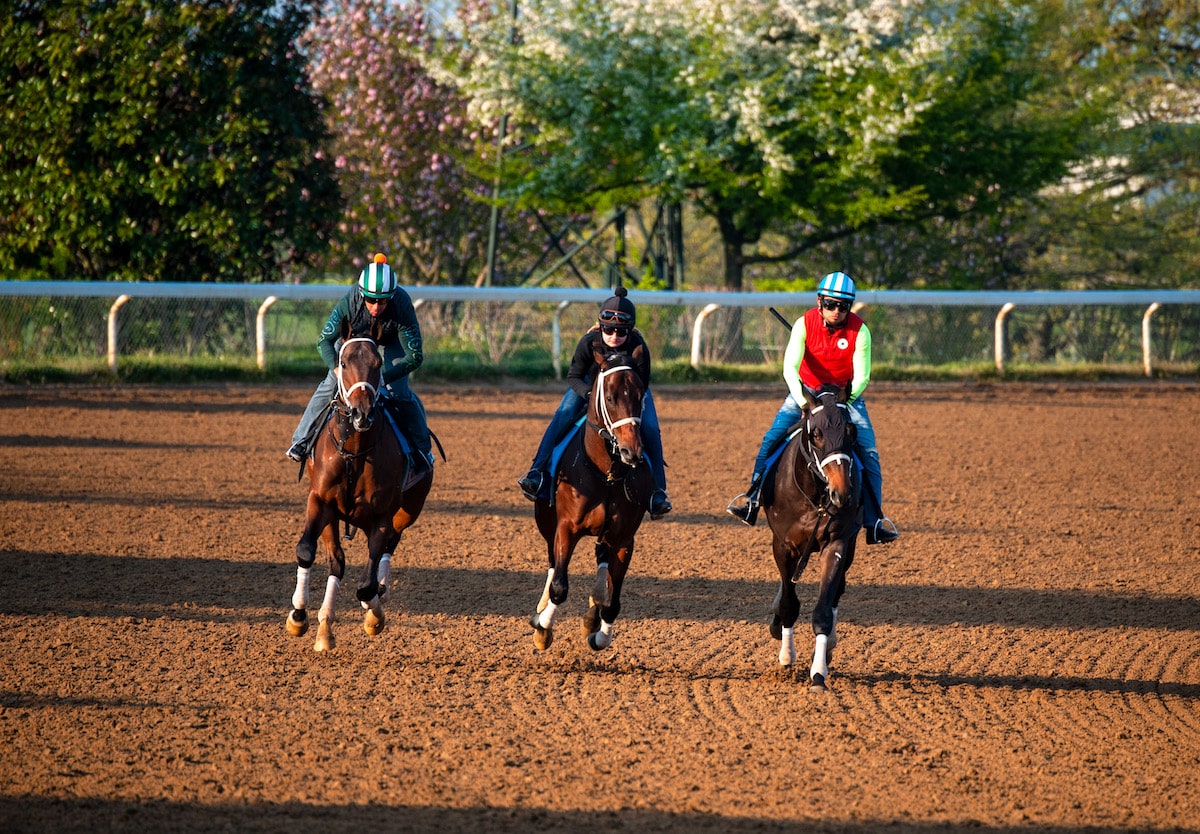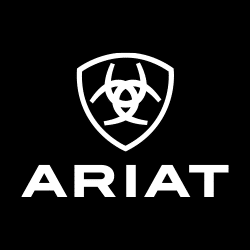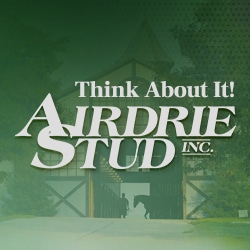Racehorses learn to do flying lead changes from an early age

Pyrois Media/Melissa Bauer-Herzog
If you’ve struggled to get your OTTB to do a clean, balanced lead change while cantering across the diagonal or collecting into a corner, it’s because you’re doing it wrong. Nearly all racehorses have been trained from a young age to swap their leads; the maneuver is integral to maintaining their balance and stamina. The key is understanding the role lead changes play in racing and training.
Why Racehorses Learn to Change Leads
During races Thoroughbreds gallop around an oval counterclockwise, or to the left. They’re not perpetually on their left leads, however. Trainers want racehorses to gallop on their right leads down the straightaways and their left leads around the turns.
“It’s a fatigue factor,” says Destin Heath, the head trainer at WinStar Farm’s training center, in Versailles, Kentucky. “Imagine you went out and rode a hand bike and just used your left hand the entire time. Your left side would become fatigued.”
Horses are the same way: They get tired if they gallop on the same lead for a prolonged period. You’ll often see them head into the last eighth of a mile of a race on their left lead, looking like they’re not really striding out. Then — voilà — they swap to the right lead and reengage. That extra step can mean the difference between hitting the board and fading to last.
“It’s because those muscles on that left side were getting fatigued to the point that they were no longer able to run to their full abilities,” Heath says.
Even if the horse isn’t necessarily fatigued, swapping leads down the stretch can help him find a new gear. “That’s going to give them a refreshed gear so they can accelerate and do their best,” says Tessa Bisha, exercise-rider-turned-assistant-trainer for Brad Cox, whose top horses include 2018 Champion 3-Year-Old Filly, Monomoy Girl.
Swapping leads also helps horses balance around the turns and stay straight down the stretch. “A horse on the incorrect lead going around a turn is going to tend to lug out, and if they’re on the incorrect lead down the lane they’re going to lug in,” says Heath — moves that can impede other horses and even result in disqualification from a race. “It’s a balance and a training tool so they can use themselves, engage their front end while using their hind end and develop the muscular structure properly.”
Training the Lead Change
Each racehorse learns lead changes at his own pace. “Some horses do it naturally, others are a little bit less coordinated and you have to show them, and the really good ones just pick it up on cue, no matter what,” says Heath.
Teaching a racehorse his leads begins as soon as he’s saddle-broke. At WinStar, for instance, Heath and his team start youngsters in a round pen, then graduate to an arena, then to riding out in groups.
“From Day 1 the horses will go on the inside lead around the round pen, either to the left or the right,” he says. “Even on the long lines we try to make it so they’re on that correct lead, and that’s where the basics really start to come around. You teach them to do it the right way before you ever get on, and then it makes it so much easier when we do transition to riders on the back and going to the track.”
Once on the track, riders will ask the horses to swap from their right to left lead going into the turn and back onto their right lead once they’ve completed the turn and straightened again. Switching leads into the turn tends to come naturally.
“It’s harder for them to stay on the wrong (right) lead while they’re turning,” says Bisha. “That change is a lot easier. You’re going to keep their nose tipped to the outside and then allow them to hop in while you ask with that outside leg and inside rein.”
Conversely, asking for the left-to-right change, “You’re going to come out of the turn and keep their head slightly cocked to the left, and then move them in toward the (inside) rail using your legs and your reins and your weight,” she says. “Then you’re going to use your outside rein and your inside leg to shift their weight out.”
Heath says it helps that many exercise riders ride “acey deucey,” or with the inside stirrup slightly longer than the outside. “That helps with the G-forces going around the turns at high speeds,” he says. “But it also helps with lead changes — just that natural balance of the weight distribution.”
In the early stages Bisha says she doesn’t worry as much about keeping the horse straight. “You are going to have to let them drift in, then move them out so they can make that dramatic jump — sort of a hop — to the other lead,” she says. “Once they start to understand what you want, you have to ask them less and less, and pretty soon you can just tip their nose toward the inside and just release that rein a bit and they’ll switch to that right lead.”
She likens teaching a racehorse to change leads to a very unrefined and high-speed version of how you’d teach a hunter, jumper, dressage horse or reiner.
“You basically use your hands, your legs and your balance to almost throw them onto the other lead,” she says. “You’re going to start there and refine it as you go, because eventually you’re not going to be able to use your legs at all because you’re riding with your stirrups short; you’re only using your weight and your hands. By the time they get to that point, they should be almost autopilot on the lead changes.”
Troubleshooting
If changing leads doesn’t become something the horse does on autopilot, it might be a sign that something’s not quite right physically — usually in the hind end.
“A horse will switch the lead from the hind end first,” says Heath. “So if there’s something going on in a hind end, usually they’ll be a little bit more reluctant to switch a lead. Or if you see a horse that switches back and forth and won’t stay on a lead for any duration of time, usually that’s a good sign there’s some sort of physical ailment going on in the hind,” which could range from muscle soreness to hock issues.
A challenging lead change might also be due to a lack of conditioning. “They have to have enough motor and impulsion to do it,” says Bisha.
“Once you get them to carry themselves and start using themselves fully, they’ll take to it a lot easier,” adds Heath.
Or, a horse might not swap his leads simply because he’s green. “A lot of times with the youngsters, it’s a combination of clueless, uncoordinated and a little bit lazy,” says Bisha. “When they’re 2 years old, before they’re fit, a lot of horses don’t prefer to gallop very forward. They might be staring at the grandstand or galloping too slow. That’s one reason why they need to train in company, because when they’re by themselves they kind of look around and lollygag.
“They’re all so different, but they learn,” she says.
Retraining Tips
Comments and complaints of OTTBs not getting their lead changes abound on online training forums. Chances are, however, the horse knows how to swap his lead; he just doesn’t know that’s what you’re asking him to do.
“It’s almost always because they have them in an indoor arena and they’re going way too slow,” says Tessa Bisha, exercise-rider-turned-assistant-trainer for Brad Cox. “They all know how to do it at a gallop.”
Bisha, who used to ride hunters and jumpers, recommends starting with your best “bad hunter rider imitation.”
“Go into the corner, tilt the horse’s head to the outside, pick up your inside rein, pull it and kick with your outside leg,” she says. “Sometimes you have to start with the final product. You want the lead change, they know how to do it, they just don’t understand the cues. Your cues are so refined and different from what they’re used to. Once you teach the horse, ‘This is what I want you to do, and here’s where I want you to do it,’ then you can work back from there.”
This article was originally published in the Fall 2019 issue of Off-Track Thoroughbred Magazine, the only publication dedicated to the Thoroughbred ex-racehorse in second careers. Want four information-packed issues a year delivered to your door or your favorite digital device? Subscribe now!










